Digital Guide
The Complete Guide to Mobile Marketing
What is Mobile Marketing?
Mobile marketing is any strategy or tactical campaign that draws attention to your brand on a mobile device. This includes outbound channels that bring visitors to your property (mobile websites and apps) as well as onsite and in-app messaging once they get there. It also includes social media channels like Facebook and Instagram, which are increasingly seen as important channels for B2C brands.
The (Brief) History of Mobile Marketing
From humble beginnings, mobile marketing has grown to become a vital aspect of a brand’s engagement strategy. It plays a role throughout the sales process and over the entirety of the customer’s lifetime. Let’s look at the biggest changes over the past 15 years.
2005: SMS Marketing
Although SMS short codes were introduced in 2003, it was another couple of years before major B2C brands fully embraced this channel as a marketing opportunity. It is sometimes seen as old-fashioned, but SMS towers above other customer engagement channels when it comes to both open rates and time-to-engage.
2007: Smartphones
Were any of us really prepared for the arrival of the iPhone in 2007 (and the Android devices that soon followed)? They are now a ubiquitous feature of everyday life and a key channel for brands to engage with their customers.
2008: Mobile Apps
When the Apple App Store went live in 2008, the entire mobile marketing game was flipped on its head! Brands suddenly had a chance to embed themselves in the lives of their customers. 552 apps were released on the store’s first day, with approximately 10 million downloads over the course of the first week. That’s an impressive figure, but throughout 2018 there were 194 billion downloads!
2009: App Push Notifications
Technically, Blackberry introduced them in 2003, but it wasn’t until 2009 when Apple launched its own push notification system that they really took off. Apple made the technology available to all of the developers and suddenly our phones were buzzing with alerts! It was another year before Google enabled them on Android devices. We’ve previously written an in-depth guide to push notifications, so check that out for more information.
2011: QR Codes
Do you remember that brief period when we all thought that augmented reality was going to play a huge role in our day-to-day lives? Yeah, that didn’t last very long. QR (Quick Response) Codes were actually around long before they entered popular consciousness, appearing in the Japanese automotive industry in 1994.
Whilst there was an initial novelty factor to QR codes at the start of the last decade and there were plenty of brands eager to trial them for marketing and advertising purposes, ultimately they were just too impractical to ever catch on. It’s just easier to type in the address of the website being promoted than it is to actually scan the QR code. The social messaging app, Snapchat, did find a use for them, to be fair. That feature cost them $54 million (to acquire Chinese company WeChat) plus additional development work.
There are suggestions that QR Codes could make a return, but it’s hard to see them ever being much more than a gimmick.
2013: Web Push Notifications
Google pioneered web pushes in 2013, but it was 2016 before they became easy for brands to implement on their own websites. By 2019, most browsers could support web pushes.
2018: GDPR
Not a technological advancement, but a significant milestone in mobile marketing. GDPR (General Data Protection Regulation) is the poster-child for digital privacy laws but it only actually governs companies operating in the European Union. The U.K. has introduced the Data Protection Act, while Japan has the Act on Protection of Personal Information. The U.S. currently has no plans to bring in something similar at a national level, but the California Consumer Privacy Act came into effect on January 1st 2020. It’s likely that other states will follow suit sooner rather than later.
These laws have changed the way in which companies collect, handle and use consumer data. Marketers now need to be certain that they are behaving in accordance with legislation when sending a campaign.
2020: The Single Platform
More recently, we’re seeing a drive towards a single platform that brands can use to orchestrate and analyse engagement across all of their engagement channels. It combines customer data, campaign attribution and execution in a single piece of software.

Mobile Marketing vs Digital Marketing: Is there a difference?
Mobile marketing is a subsection of digital marketing. In the very near future, however, there may be little or no distinction between these terms as smartphones and tablets more or less replace desktops entirely.
Within larger marketing departments, it’s not usual for mobile to have its dedicated team working independently from their colleagues. This inevitably leads to siloed data and disjointed campaigns. More and more companies are seeking to address this through the implementation of Customer Data Platforms and Mobile Marketing Platforms to facilitate cross-channel customer engagement.
Mobile Marketing vs Mobile Advertising
For many, advertising is seen as a subsection of marketing and this is largely true of the mobile sector. And whilst there are obvious links between these two ideas, they are ultimately distinct. For the purposes of this guide, we should be clear what is meant by each of them.
Mobile advertising is predominantly concerned with display ads. By now we are all familiar with website cookies, which enable brands to target potential customers with ads when they navigate away from their site. It is a passive method of connecting with a target audience, wholly reliant on your content standing out sufficiently to distract the user away from their current objective. It differs very little from digital advertising in general, essentially behaving in the exact same way as desktop advertising, just with smaller images! With third-party cookies becoming a thing of the past, some believe that mobile advertising is dying a slow death.
When we talk about mobile marketing in the context of customer engagement, however, we are looking at ways to leverage channels and capabilities unique to mobile devices, as well as incorporating emails optimised for the smaller screen (as most emails are now read on mobile devices).
Is Mobile Marketing Effective?
Yes, to the point that’s essential for pretty much every B2C brand! You’d struggle to think of a company that would not benefit from an improved mobile marketing strategy. The 2018 survey below was carried out by global IT consultancy Gartner. Their research pooled opinions from hundreds of B2C brands across a wide range of industries. The findings reveal the effectiveness of mobile marketing at every stage of the buyer’s journey in comparison to the alternatives.

(Source “Use Mobile to Connect Your Customer Experience Across Channels” Gartner, Published 22 August 2018)
The report really puts a fine point on what most brands are noticing on a day-to-day basis; more and more decisions are being made on mobile devices.
Should I prioritise mobile marketing?
Below is a list of attributes that are commonly shared by companies who can benefit from a mobile-centric marketing strategy. In some cases, delivery to a mobile device may be the only option, but where there is a choice, mobile is the optimal way for both brand and customer.
Digital pure play
Your brand is an entirely online proposition, selling a service or products that exist only online. A contenting streaming platform or a digital publisher would be two typical examples here. Although you may have several digital options available, chances are your customers are tech-savvy users who predominantly use their smartphone or tablet to purchase and use your product.
Urgent or time-sensitive communications
If you regularly send out campaigns that contain urgent or semi-urgent messages (e.g. “your order is on the way”, “your subscription is about to expire”, “you’ve logged in from a new device”) then a mobile channel is absolutely the most effective way to communicate it. It may be that SMS is the best route, as it has a +90% open rate.
Regular contact
If, either by necessity or choice, you engage with your customer base on a frequent basis (more than once a week) then identifying the right mobile channel should be a priority.
Mobile app
There’s no doubt if your brand has an app that is an important part of your marketing strategy then mobile-centricity is key. Push notifications, in-app messages and an app inbox are three channels that will help you increase the number of active monthly users, increase wallet-share from them and retain them for longer.
If you can relate to some of these attributes then you should strongly consider adopting a mobile-centric approach.
Mobile Marketing Statistics
What’s that old saying, “There are three kinds of lies: lies, damned lies and statistics”? It’s true that stats can be misleading, but the following little nuggets certainly all point to the continued rise and importance of mobile marketing.
- The average American spends 5.4 hours per day on their smartphone. Millennials are unsurprisingly the biggest age group in terms of usage, so it’s likely this figure will increase significantly over the next 10 years.
- Approximately 2 hours of that time is spent browsing social media, with apps in general accounting for a whopping 90%. But don’t despair if you only have a website because…
- By the end of Q4 2019, mobile web browsing had close to 53% of the total global share. That’s a 20-point increase since 2015 by the way! In the US, it’s at about 57%.
- 80% of in-store buyers use their smartphones while shopping. They’re looking up reviews and of course, cheaper deals online.
- 75% of us check our emails on mobile devices.
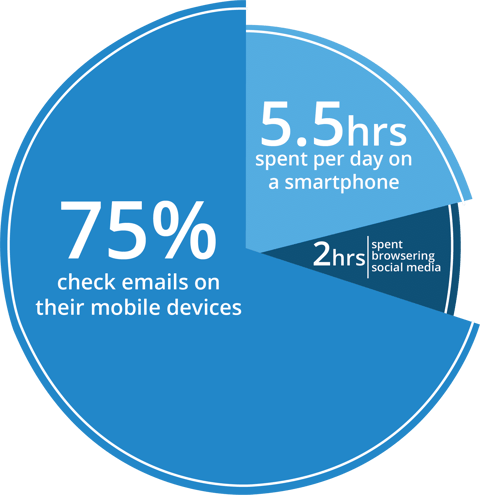
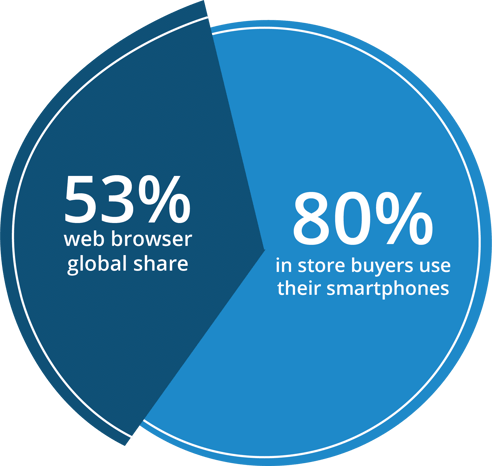
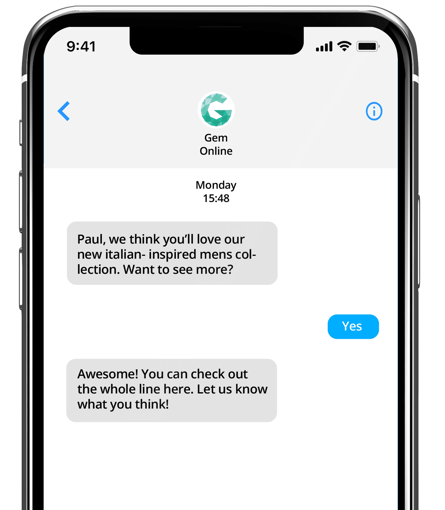
Mobile Marketing Channels
SMS
Reports of its death have been wildly exaggerated. Maybe you’ve heard the stats, and maybe you haven’t, but with an average open rate above 90%, SMS needs to be taken seriously.
To be fair, the SMS game has changed a lot. Now, brands are leveraging MMS (multimedia messaging services) and RCS (rich communication services) to create more dynamic experiences that extend beyond the bare text.
Mobile App Engagement Channels
When it comes to driving engagement with your mobile app there are three key channels; push notifications, in-app messages and the app inbox.
These are delivered through the app while it’s in use.
Customers incorporate this channel into their app engagement campaigns in a variety of ways, driving business goals at every stage of the funnel.
We’ve seen them feature prominently during app onboarding and welcome series, but we also work with brands that use them to recover abandoned carts.
One of the big advantages of in-app messaging is that you have several formatting options, depending on the message you are sending. You can choose a subtle banner, or go all out with a full-page takeover.
And you can also be selective with who receives a particular in-app message, segmenting your audience based on any number of attributes and behaviours.
Learn more about this channel with our guide to in-app messages.
If your brand has an app then you need to start sending push notifications. It has to be pointed out though that it’s a permission-based channel. Android users automatically give consent when they download an app, but iOS users must go and do that manually.
But who knows if and when this will change?
In any case, here’s a guide to convincing your app users to opt-in for push notifications.
App Inbox
This channel acts as an inbox which stores messages you send to an app user. You can set an expiry date on the message or mark it as permanent, depending on how time-sensitive it is.
Again, there are a host of business goals that an app inbox can help you achieve. In terms of formatting, you can either choose your service provider’s default template or build a custom one using HTML.
Here’s a more in-depth piece we’ve written on the value of the app inbox and its use cases.
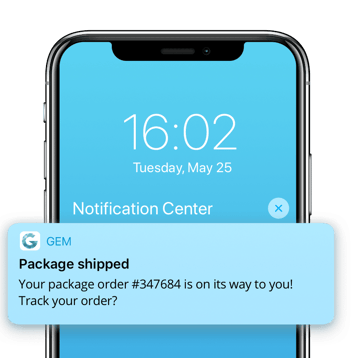
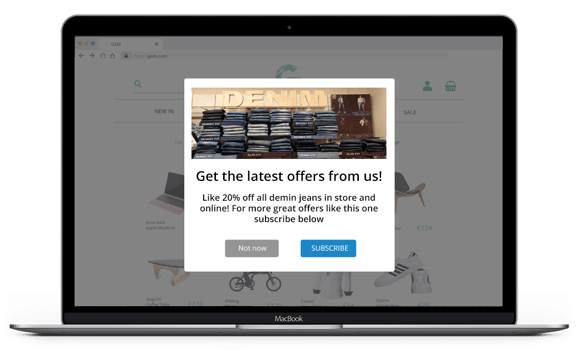
Mobile Website Engagement Channels
We’re going to cover three similar channels here; web push, on-site messages and the web inbox.
Web pushes are perfect for driving traffic to your website, whilst the other two are used to keep visitors engaged for longer and to create new conversion opportunities.
Onsite messagesYou are probably familiar with the classic “pop-up”. They are a common sight on many websites, serving a variety of purposes. They are often used to share “similar content” in the middle of a browsing session, promote flash sales or grow an email subscription list.
Up until a few years ago, digital marketers were reliant on providers like Unbounce to launch these highly effective engagement messages. Not only have platforms like Xtremepush made it easier to create an on-site message but they have also vastly enhanced their functionality. Following a simple SDK deployment (which requires minimal input from a developer or web-master), you can start sending them straight-away.
One nice detail to note about in-web messages, they do not require the visitor opt-in! And they can be triggered by pretty much any onsite behaviour, like the number of page views, specific page viewed and dwell time.
Onsite messages give you plenty of creative freedom, supporting large images that can be used to strengthen your marketing message (and there’s no text limit, either). They also support up to two CTA buttons, so you can drive more or less any business objective you have.
Web push is an increasingly important channel for many brands, engaging both “anonymous” website traffic and existing customers with timely, personalised messages. This is especially true considering the decline of display advertising.
If you have a mobile website that’s converting well then you should strongly consider web push as an engagement channel. Each message can be deep-linked, directing the recipient to any page you like.
Similarly, if you’re finding it difficult to remarket to website traffic, web pushes give you another chance to engage them. This all depends on getting your opt-in messaging right, however.
We’ve written elsewhere in greater depth about web pushes so if you want to learn all there is know about them, from set-up to practical use cases, we recommend you take a look at that article.
If you are already sending web pushes, then check out this guide we’ve written on creating the perfect web push for eCommerce brands.
Now, this might be a customer engagement channel you are less familiar with. It’s not all that common, despite its usefulness.
As brilliant as web pushes can be, they disappear once they’ve been engaged with or dismissed (hopefully not too often!). This makes them a less than an ideal channel for evergreen content or offers that last for a long period (like a Summer sale).
A web inbox is perfect for sharing these messages with your website visitors.
An icon (often a bell, but it can be anything you want) is added somewhere prominently on your website. Clicking on it opens up the notification centre. Again, this can be customised to reflect your brand’s colours. Essentially, this behaves like an email inbox, acting as a place to store all of the push notifications that each user has received from you.
The user doesn’t need to create an account, either, as the Xtremepush platform tracks the profile based on the Device I.D.
It also gives you repeat opportunities to convince visitors to opt-in for web pushes, with a simple on/off toggle that makes it easy without having to go into their browser’s notification settings.
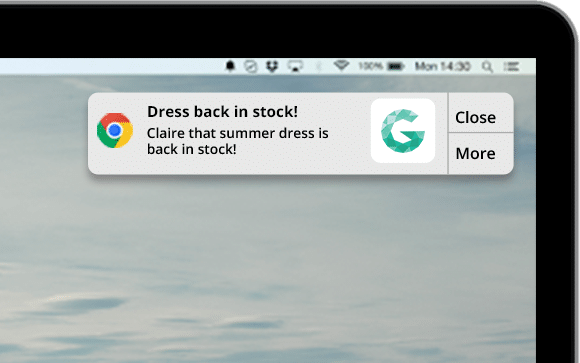

The Essential Mobile Marketing Tools & Capabilities
Campaign automation tools
Unless you have a very deep budget for human resources (and let’s face it, no-one does!) then you’re going to need to automate your digital engagement campaigns to achieve results at speed and scale.
Intelligent workflows, built around dynamic message templates, allow you to deftly nudge customers towards goal completion time after time. It could be an onboarding or welcome series, intended to drip-feed information at a consistent pace or it might be an abandoned cart recovery campaign that brings users back to the checkout.
The Xtremepush customer journey-builder, Maxautomation, has been designed with multichannel marketing in mind. It allows our clients to efficiently orchestrate otherwise complicated cross-channel campaigns.
One of our biggest clients, Oddschecker, the world’s leading odds comparison website, launched over 100 dynamic campaigns, across 5 channels, over the course of a single week. They were able to do this with a team of just three people. You can read more about our work with Oddschecker.
Customer segmentation
Segments are created based on known behavioural data (particular pages visited, app usage, etc) as well as characteristics (nationality, location, age, gender).
The most powerful segments are the ones that combine several pieces of information to create incredibly rich, individually-specific user groups. Once you have these groups, it becomes so much easier to drive business goals.
Let’s say, for example, you wanted to increase your number of monthly active app users.
Rather sending a re-engagement campaign to everyone with the app, you’d want to create a dynamic segment of users who haven’t opened it in two weeks (or whatever time-frame you like).
To give yourself the best chance of re-engaging them, you then further segment that list by a secondary attribute (such as products bought or favourite sport). You can now send these smaller lists personalised, relevant and compelling messages that will have higher engagement rates than a generic blast.
A/B testing
Whether it’s the exact wording of an offer (does “sale” or “discount” get more clicks?) or the nature of the promotion (10% off for 24 hours or 20% off for 12 hours?), digital marketers need to A/B test their campaigns to get the best results.
Multivariate testing, as it’s sometimes called, should play a role across all of your mobile marketing campaigns. It’s the only way you’ll be able to optimise your messages for conversions and maximise ROI.
The more you test, the more you learn about both your products and your customers. Which type of products generate the most interest and what type of language resonates strongest with your audience?
Personalisation
Personalisation means different things to different people. There’s some uncertainty out there regarding what’s actually possible and how achievable it is at scale.
For some, it goes no further than including the recipient’s first name in the message. That’s certainly one aspect, but true one to one marketing goes much deeper.
It’s really about using all of the available data you have about your customers, from order details to behavioural patterns and preferred content, to deliver individually relevant experiences. As consumers, we expect our favourite brands to know more about us, and to use that information to add genuine value to our lives.
Mobile Marketing Platforms
Mobile Marketing Platforms, often abbreviated to MMPs, are pieces of software that facilitate the creation and delivery of mobile-centric marketing campaigns.
They possess deep capabilities in mobile-specific channels we’ve mentioned like in-app messaging, push notifications and SMS and excel in capturing usage analytics for mobile devices (as well as desktop users). Some MMP providers will also provide email and web channels like browser push and on-site messaging. Again, this demonstrates that there is always going to be some cross-over between mobile-centric marketing tactics and a general digital marketing strategy.
A comprehensive Mobile Marketing Platform can act as both the intelligence centre and actioning arm for all of your digital marketing tactics. It differs from a Multichannel Marketing Hub (MMH) mainly in relation to the richness of features it offers and the depth of channels available. Typically, the leading MMHs excel in email performance but lack the necessary sophistication elsewhere.
In terms of use cases, Gartner assesses MMPs on the basis of their ability to help brands acquire, engage and retain customers. There are a number of factors which contribute to an MMP’s overall efficacy in these categories; the number of channels, the ability to scale as message volume increases, enterprise-grade analytics, real-time functionality, a robust automation or workflow builder, custom segmentation options and campaign optimisation tools.
Beyond the features mentioned, one of the most attractive aspects of purchasing an MMP is the elimination of point solutions. By running all of your communication channels through a single interface you not only save a huge amount of time, but you also reduce your costs. A Mobile Marketing Platform will also help you to execute cross-channel campaigns, connecting with customers at the ideal moment and through the most effective medium.
Permission and consumer privacy in Mobile Marketing
GDPR, and its counterparts around the world, have made permission marketing a non-negotiable.
There are some marketers that pine for the “good old days” when you could be less worried about who you were sending messages to. But the very best professionals have been playing by the rules for a lot longer than 2018, when GDPR came into effect.
Rather than cursing your luck that you have to operate under the careful eye of consumer watchdogs, however, we recommend that brands really embrace the limitations that privacy laws have placed on digital engagement.
You’re probably already familiar with the concept of “opting in” to receive marketing communications. We’ve written before about the importance of getting this right. In some cases, you may only have a single opportunity to convince your audience to listen. Some of the newer engagement channels, like web push notifications, have permission-requirements at their very core. You need to have consent before you can even begin to start sending messages.
Brands must realise that we are only at the beginning of the privacy-era. Laws are going to become more stringent and the penalties for getting it wrong will increase. That’s why we have adhered to the philosophy of privacy by design throughout the development of our mobile marketing platform. We want to help brands not only stay on the right side of compliance laws by default, but also foster brand loyalty in doing so.
By making the privacy of your customers a priority you can actually forge better relationships with them that will yield more ROI in the long-term.
Mobile Marketing Trends
Right now we’re seeing a couple of trends across the board, that are impacting brands in every vertical, from ecommerce to retail banking.
Multichannel journeys
Firstly, brands are waking up to the reality that their customers’ journey to purchase is increasingly non-linear, and taking the action needed to understand this behaviour. Mobile devices feature at every stage of the sales funnel, sometimes exclusively and at other times just playing a supporting role. The number one trend in mobile marketing is the Single Customer View (SCV); in other words, gaining a complete picture of your audience’s interactions across every touchpoint.
The biggest barrier to a SCV is data silos. The cause of data silos is part technological and part organisational. In 2020, brands en masse will make moves to consolidate their different strands of data into one location, either through a Customer Data Platform or a Mobile Marketing Platform with CDP-like capabilities.
The second trend is the decline of digital advertising, at least in its original form. The risk of fraudulent click-farming is still too high for comfort, and brands demand value for their dollar. Some reports suggest that non-human traffic accounts for between 4-11% of ad clicks. It’s not just web traffic that is being exaggerated, but even the number of app downloads driven from them too. A trustworthy attribution partner can help you get a clearer picture of how your advertising budget is being sent and the impact it’s actually having.
Even when banner ads are getting in front of the right audience, their effectiveness has always been in question. Click-through rates for digital advertising have hovered consistently at around .1%. That’s one in every thousand views.
Instead, we’ll start to see more and more “native advertising”. These are sponsored articles, blog posts, expert recommendations and so on, which are seen as less intrusive or aggressive than display ads.
What we’re noticing, however, is that brands overall are reducing their ad spend and investing more resources in increasing the lifetime value of existing customers, through personalised engagement and customised loyalty programmes. This shouldn’t surprise anyone; we all know the costs of acquisition versus retention.
For many brands, this has been a focus for the past couple of years. Real-time marketing is all about delivering personalised, contextually relevant messages that are triggered by events on your website or app. This could be anything from a failed log-in attempt to clear exit-intent on a particular page.
The value of real-time engagement is that gives you the chance to acquire, engage or retain (to hark bark to our three kinds of use cases) customers as the opportunity occurs. The best time to solve a customer’s problem is straight away, and the best time to share an offer is while you already have their interest and attention.
For the sports betting and gaming industry, the rise of in-play betting has made right-time capabilities a mush have. Even if you aren’t in that industry, it’s worth reading the article we’ve just linked to, as some of the use cases we cover could just as easily apply to other verticals.
Do app and web push notifications need to be used together?
Not at all. Although brands will often use them both as part of their multichannel marketing campaigns, they are separate channels that work independently of one another. It wouldn’t be uncommon for brands to have profiles in their database that can be engaged on both channels, but it is not essential.
Problems can arise if you are using a different service provider for each of them, however. This leads to data silos and in some cases double-messaging. You don’t want to send someone both a web and app push at the same time. That’s why a unified platform that handles both of them is the preferred option, rather than having two disconnected point solutions.
*You do not need an app to send a web push notification!
Web push notifications vs App push notifications: Key differences
Let’s start with the obvious difference. App pushes are linked to, yes, you’ve guessed it, apps! If your brand doesn’t have one then you cannot send them.
Web push notifications are linked to websites and are sent via the browser.
In terms of the user experience, there are some important differences between the two to note.
App Push
• Can only be sent to mobiles
• Can be delivered to mobiles even while in lock mode
• Apps need to be updated and this can lead to drop-offs
• Depending on the device’s operating system, can support rich media
Web Push
• Can be sent to any device that supports web browsers
• The device must be in use
• The user does not need to install anything
• User can receive the push even while browsing another website
How web pushes appear on different devices
As you can see in the image below, there is a significant difference between the appearance of a web push on a Mac and Windows device. Marketers need to take this in account when creating a campaign.
iOS (iPhone) vs Android push notifications
The most important thing to point out here, from the sender’s perspective, is that iOS users must “opt in” (more on how to optimise this later) whereas Android users automatically give permission when they download the app.
If you’re wondering which platform you should focus on, then the answer is both! Here’s a really useful article on global usage and engagement rates.
One area in which Android phones stole a march on their rivals was in regard to rich media (initially just images). It took Apple a little while to catch up but now they are leading the way, allowing brands to include gifs, video and sounds as part of their pushes.
How rich app pushes appear on different devices
How do I send push notifications?
Adding push to your mobile app
Minor differences between the various operating services aside, the steps required to send notifications from your app are pretty much as follows.
- Create push credentials on Firebase and Apple developer consoles
- Add the service provider’s SDK to the app
- Save these credentials in the initialisation of the service provider’s SDK
- Set any other optional configurations for other functionality
- The user will then be prompted to give push permissions (iOS only) on app launch
- Send push messages to the user

How to send a web browser push from your website
You might think that is a complicated process, but it’s relatively straightforward (provided you know what you’re doing). Typically, our development team can get a client’s website ready to send push notifications in a matter of hours.
The steps involved are;
- Add the service provider’s SDK to the site (edit the JavaScript or add with Google Tag Manager)
- Create push credentials on Firebase and Apple developer consoles
- Save these credentials in the service provider’s settings along with an icon for the application
- Set the location that the supporting files are located on the SDK Integration page on the platform, if necessary
- Prompt the user for permission to send them push messages with the service provider’s SDK, ideally from a value exchange or button on the site
- Send push messages to the user
Don’t worry, if this all seems a little beyond your technical capabilities. A good service provider will guide you through it, or even just take care of it themselves!
Can I send push notifications to anyone who has my app or visits my website?
Potentially, yes. There’s a little bit more it than that, however.
Each individual recipient must be “opted in” and have notifications turned on for the specific device. Once again, there are some differences here between app and web browser pushes. And they are differences between phones running on Android and iOS systems too.
As we mentioned earlier, when an Android user downloads an app, they automatically consent to receiving pushes from it. iPhone users must actively give permission to each app.
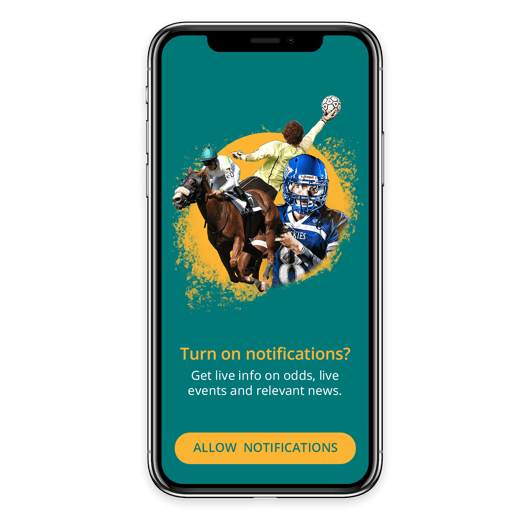
Convincing users to opt in for push notifications
You’ve probably been asked to opt in at least once today already!
It’s a vital part of the process and one that you don’t want to get wrong, as it will undermine your brand and lessen the reach of your campaigns. One of the classic errors that people make is sending the opt-in request too soon.
How many times have you visited a website for the first time, or just opened a newly downloaded app, only to be immediately asked if you want to receive regular updates?
I’ll bet that more often than not you say no, or “maybe later”. Why should you give permission straightaway? You haven’t had time to a) find the information or complete the task you had in mind and b) the brand hasn’t yet communicated its value.
Let’s just linger on that last word a little bit longer, “value”. We talk about the “value exchange” here when devising an opt-in strategy with new clients. It’s an important principle that should never be overlooked.
Fundamentally, if you want to convince more users to opt in, you must be able to answer the following question; what’s in it for them? It’s very clear what the brand’s reward is in the exchange, but you want to make sure the user is satisfied with what they’ll be getting out of it.
If you’re interested, you can read more about app-specific strategies and best practices in this article.
We’ve also written this guide to help you get more opt-ins for web push notifications too!
Why is sending push notifications a good idea?
The short answer? Because they work. Brands that send pushes see increases in engagement rates as high as 85%.
They can be used to achieve a wide variety of business goals and are a highly effective means of sharing valuable content with your audience on their preferred device.
Real-time event triggers
This is perhaps the biggest appeal. It’s a chance to engage your audience as they are using the device. Contrast that to an email, where it could be hours before the recipient sees it, if at all.
App and web push campaigns can be triggered by actions or behavioural patterns and delivered to the user in real-time. This allows you to capitalise on engagement opportunities as they occur. Each notification can be deeplinked to a specific page within the app or on your website.
Dynamic content
When personalising a message with the recipient’s name (whether it’s via email, sms or a push notification), that information is pulled from the profiles stored in your marketing platform. Dynamic content refers to continuously updated information that is pulled in from an API (application programming interface) or your own server. There’s no limit to the types of information that can be pulled in, but common examples include live score updates, weather reports and breaking news stories.
Cost efficient
Compared to the cost of an sms message, the most similar channel in terms of immediacy, push notifications are relatively inexpensive. This makes them ideal channels for reaching a huge volume of users and generating ROI.
Best practices for effective push notifications
They need to be relevant to the recipient
Our CEO, Tommy Kearns, is fond of the following saying, “Success leaves clues”.
Let’s think back to earlier when we looked at the history of push notifications.
Why were they so popular amongst BlackBerry’s users? Why weren’t they clamouring to opt out or turn them off?
The answer is obvious.
I don’t mean to be flippant, but BlackBerry wasn’t sending its users notifications about other people’s emails, were they?
What’s the learning here? Push notifications, on any device, must be relevant to the recipient. The brands who have success with pushes are the ones who have the technical resources to first acquire sufficient customer data and secondly, to put it to proper use.
This goes beyond adding the customer’s first name by the way. I’m talking about knowing which pages of your website they’ve visited and for how long. It’s about leveraging the information you have about their purchase history so that you don’t send a push that’s selling the same thing they’ve recently bought. (How often has that happened to you?)
If you were in the sports betting and gaming industry you’d want to know which types of bets or games each user likes to play so that you can let them know what’s available in those categories.
This is how you ensure your pushes add value to a customer’s experience, instead of irritating them and damaging your relationship.
If you follow this advice then the worst possible response your push notification will get is “I won’t engage with this now, but maybe later”.
Why personalised push notifications matter
The days of “Dear customer” are past. The modern consumer expects the brands it chooses to know more about them.
And it’s worth it. A notification with personalised content is 4 times more likely to be engaged with, compared to a generic message.
Personalisation goes beyond using the customer’s name, however. It’s also about understanding their interests and demonstrating an awareness of their purchase history and interaction with your brand.
The image on the right is a very simple example of how a customer’s data can be leveraged to create a more impactful engagement.

What’s the best time to send a push notification?
There’s no simple answer to this question, unfortunately! It comes down to the purpose of the message, the industry and relevancy of the content.
For some brands, they might find that campaigns sent in the early hours, hoping to catch people on their morning commute, work best. For others, their notifications might be a welcome relief from the boredom of work. You won’t know for sure unless you are running A/B tests and continuously for marginal gains.
Some marketers have a concern that pushes run the risk of over messaging their userbase. And this is indeed a possibility This only happens if you are not creating segments and send generic, irrelevant content.
While we’re on that subject, proper segmentation is vital if you want to create a successful one to one marketing campaign.
So long as you make sure the messages add value to your customer’s online experience you’ll be fine!
If you want to read about this topic in more detail, we have written an in-depth guide on when brands should send app push notifications.
Do users want to receive push notifications?
As they are permission-based, the user has complete control over the notifications they receive. It’s very straightforward to turn them off or opt out, so if they haven’t done this for your brand then it’s natural to assume they want to hear from you. See how push notifications compare to SMS and email here.
Unsurprisingly, in terms of opt-ins, social media leads the way, with users keen to hear about who has followed, shared or like them. News apps also perform well here, especially when the brand can segment and target users based on individual interests.
Brands in other verticals can have a harder time convincing users of their pushes’ value. It’s vitally important that they get the “value exchange” right.
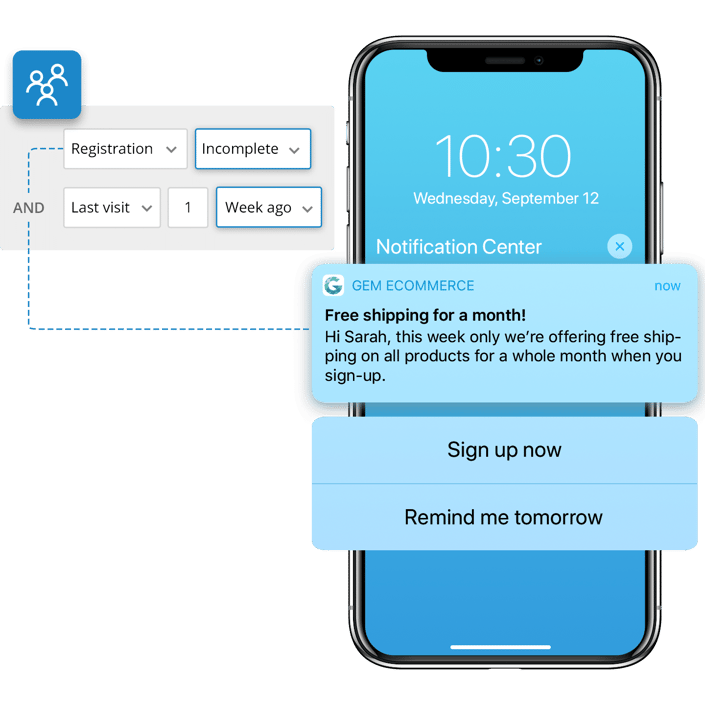
5 main purposes of push notifications
Welcome campaigns
70% of people who download apps are inactive after just three days. Their initial impressions of and experiences with the app must be good if you want them to form lasting engagement habits.
A cleverly mapped-out welcome campaign, automating app push notifications that direct users towards its most valuable and useful features (from a user’s perspective) will go a long way towards achieving this goal.
The goals are much the same for that first couple of web pushes; make the user aware of your most valuable content and perhaps even offer them a welcome discount on selected products.
In general, you want to get them into the sales cycle as soon as possible, whatever form that takes for your business model.
Sales and promotions
As we noted earlier, push notifications don’t actually require the user to be engaging with your website or app to receive them. This makes them ideal channels to promote sales and share the latest deals with your database.
In this example, a web push, the content has been personalised with the exact offer taking into account Simon’s previous purchase history. Naturally, push notifications are ideal channels for ecommerce brands.
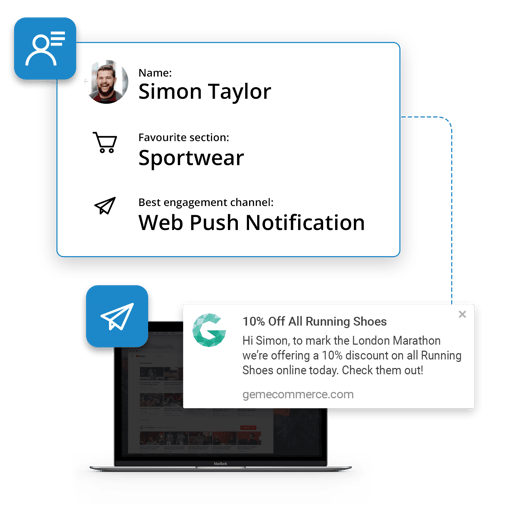
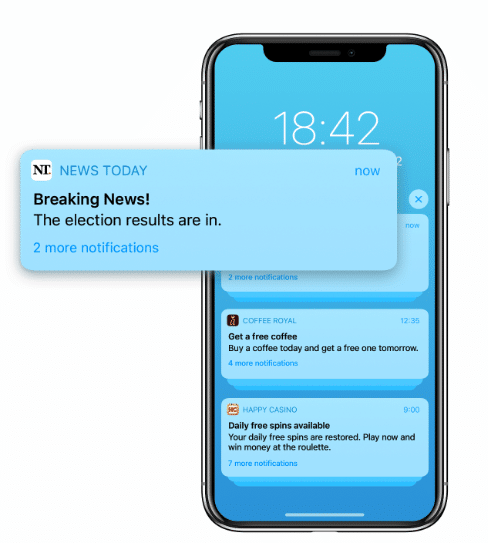
Customer education
Depending on your brand’s business model and vertical, you may not actually be selling anything at all. It could be that you are providing a service, or want to let your users know about a product update or some other crucial, relevant piece of information.
Once again, push notifications are perfect for this.
Transactional messaging and information
This is vital right now in the retail banking industry, for example, where the neo banks like Revolut are shaking things up with an exceptional standard of transactional messaging. We’ve helped a number of tier-one banks roll out automated app push campaigns that provide customers with a real-time record of every transaction in or out of their account.
Across other verticals, the same principle applies. You might want to send your customers notifications about expected delivery times or even ask them for a product review when it has arrived. These pushes can be automated very simply and strengthen the bond between your brand and the customer.

Customer retention
As pushes are delivered instantly to a device as it’s in use, this makes them ideal channels to win back lapsed customers. Nudge users directly to the app or website with a personalised offer that leverages that data you have in your CRM system. Segment users based on the date of their last activity and send a push notification to their preferred device.

Use cases and best practices for push notifications in digital marketing
We think about push notifications as having three distinct, audience-centered goals; acquire, engage, retain. When we begin working with a new client it’s crucial to us that we help them achieve these core marketing objectives.
We’ll cover one use case each for both app and web pushes across all three, but there are plenty more!
Acquisition
App onboarding and first-purchase campaigns (app push)
How many of the people who have downloaded your brand’s app never even got beyond the log-in? (If you don’t have exact figures for this then you are missing out on some very important data)
Across every industry, the average number of app users who don’t complete the registration phase stands at 20%.
When you consider the resources that go into building and promoting an app, it’s incredibly frustrating to see users drop off before you’ve seen any return on your investment.
Of course, there’s plenty of reasons why this happens. Essentially though, it boils down to two; the user either got distracted (maybe even by another push notification!) or they simply didn’t see the point in signing up.
A well-timed, personalised app push can both communicate the value of completing their registration and nudge them back in the app to do so.
In the example here, the user has been given a clear incentive to sign-up and make their first in-app purchase.
We’ve seen brands increase the number of registered, active users by upwards of 10% with push notifications. This in turn creates so many more opportunities to engage your audience and drive business goals.

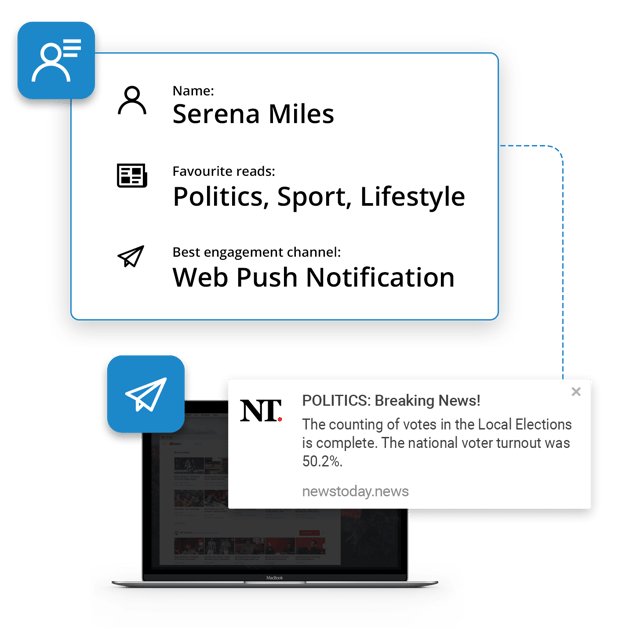
Retargeting website visitors (web push)
You’ve possibly seen this stat batted around, but it bears repeating; only 2% of web traffic converts on their first visit to a site. It begs the question, what’s the best way to re-engage the other 98%?
Maybe you’ve dipped a toe into the world of cookies and retargeted ads. I’d confidently wager you’ve seen very mixed results with that.
How come I’m so sure? The average engagement rate for these ads is .7%. And no, that decimal point isn’t in the wrong place.
Web push notifications perform substantially better. That shouldn’t surprise you too much, after all, as we’ve said, they are permission-based. The recipient wants to be notified. (Provided you are sticking to best practices as we outlined early)
Of course, it will vary from vertical to vertical, but the average CTR for a web push ranges from 10% to 30%. Wouldn’t you take that over .7% every day of the week?
Engagement
Real-time messages (app and web push)
This is something that is becoming increasingly important to sports betting brands, but applies across all verticals (especially publishing and media).
Capitalise on engagement opportunities as they arise and stay ahead of your competitors.
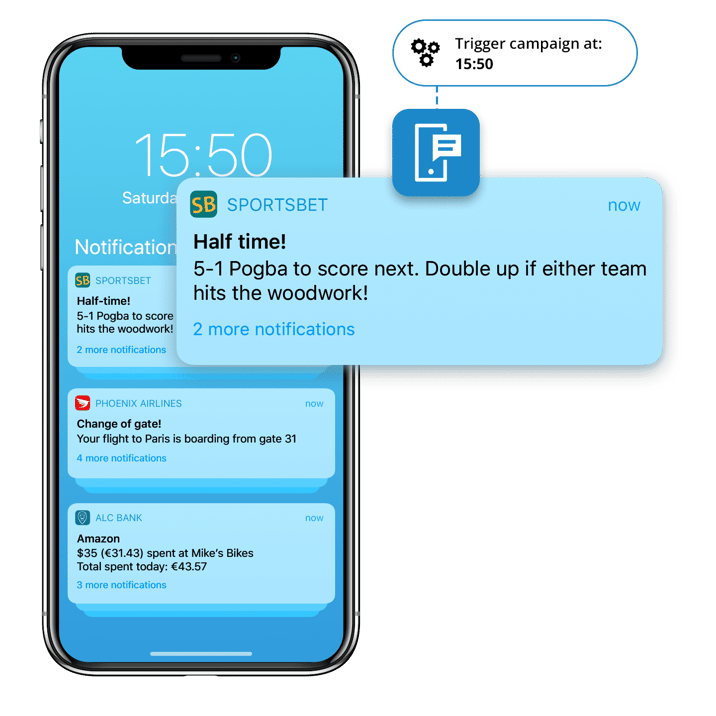
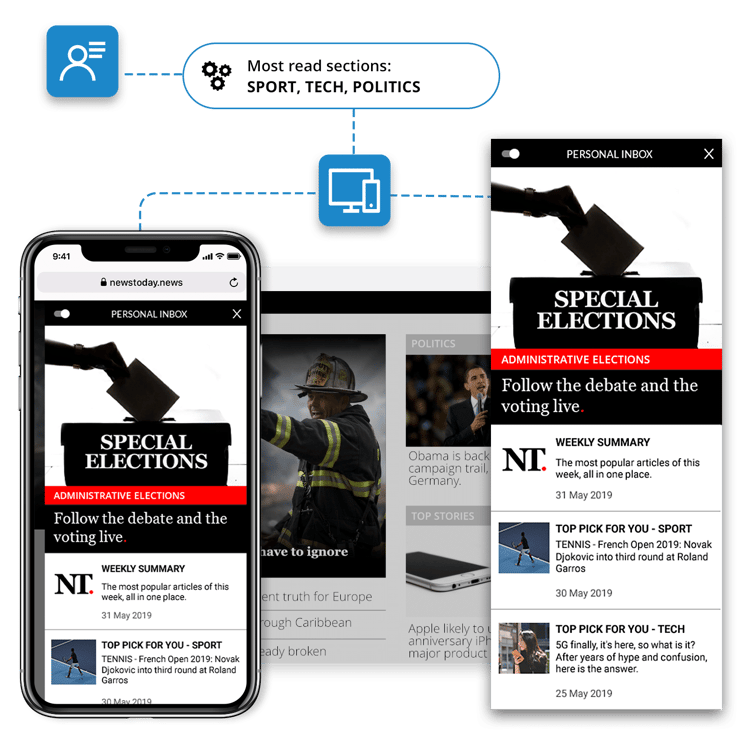
Drive traffic to your website and app
Promote content to your website and app users that you know they are interested in. This is particularly important in the publishing industry, where increasing revenue from advertising is a core business objective. Push notifications, sent at the optimal time to intelligently targeted segments, drive traffic back to the website or app.
Retention
Recovering abandoned carts (app and web push)
I’m struggling to think of an industry that doesn’t have abandonment issues. It’s a digital epidemic, with approximately 70% of all baskets left behind at the checkout.
There’s been plenty written about the reasons why, so we won’t go into that here. Suffice to say, too many customers get cold feet about hitting the purchase button and back out.
So where does that leave you, the brand that’s missing out on all of those sales? How can you win them back?
Push notifications are high-performing options in each of these cases.
They can be deeplinked, directing the recipient back to their pre-populated basket at the optimal time. Which of the two you choose (if you have the option, of course) depends on the device they used to shop and the individual’s preference (based on previous engagement rates).
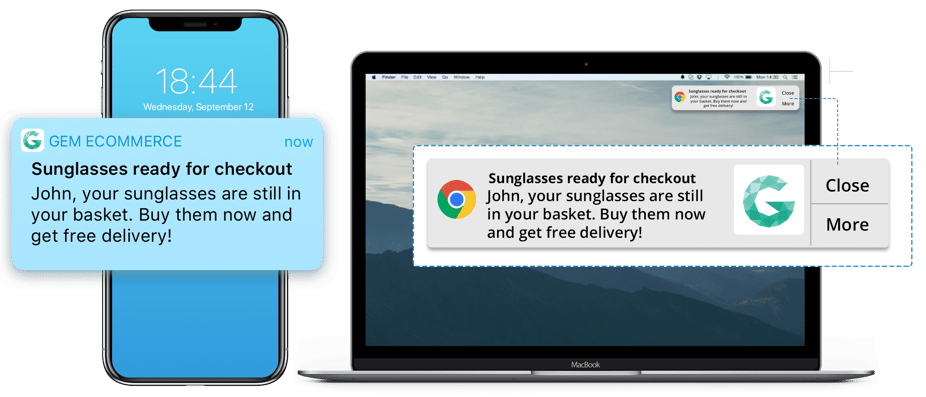
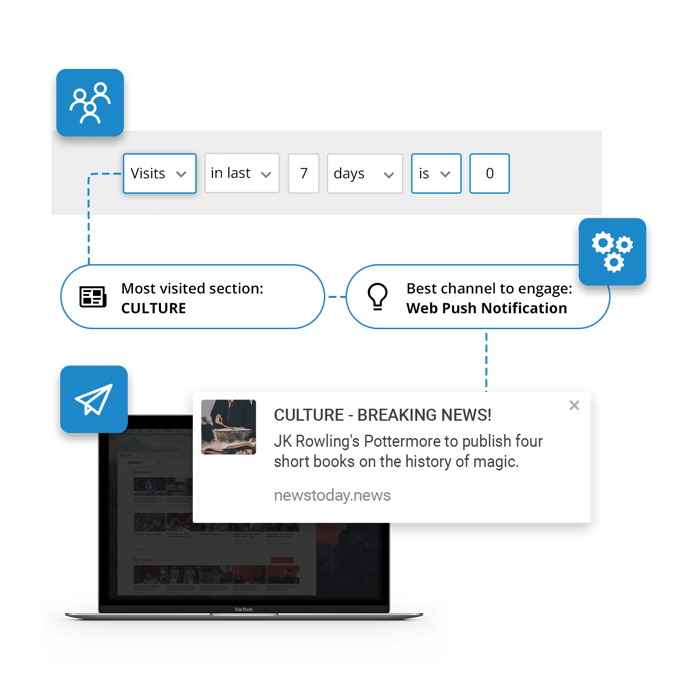
Re-engaging lapsed users (App and web push)
Despite your best efforts there will always be a certain amount of website visitors or app users that drift away and eventually fall dormant.
In the publishing and media and sports betting and gaming industries, in particular, there is a pronounced risk of churn due to a high volume of competition.
In this example, you can see how intelligent segmentation and personalisation (which we talked about earlier) has been used to ensure the content in each case is relevant to the recipient. This makes them far more likely to win the user back and get them into the sales cycle once again.
Switching Email Provider
If you’ve been reading this article and lamenting the fact that you currently don’t have the ability to execute some, or maybe most, of the tactics we’ve covered then it might be time to think about a new service provider.
It’s a big decision, we know, and marketers are often worried that they may lose data during the migration or have to halt their campaigns.
If you choose a reputable and experienced email vendor then you have nothing to worry about. Check out this guide we’ve written on what to look for and how to prepare when switching email service provider.












